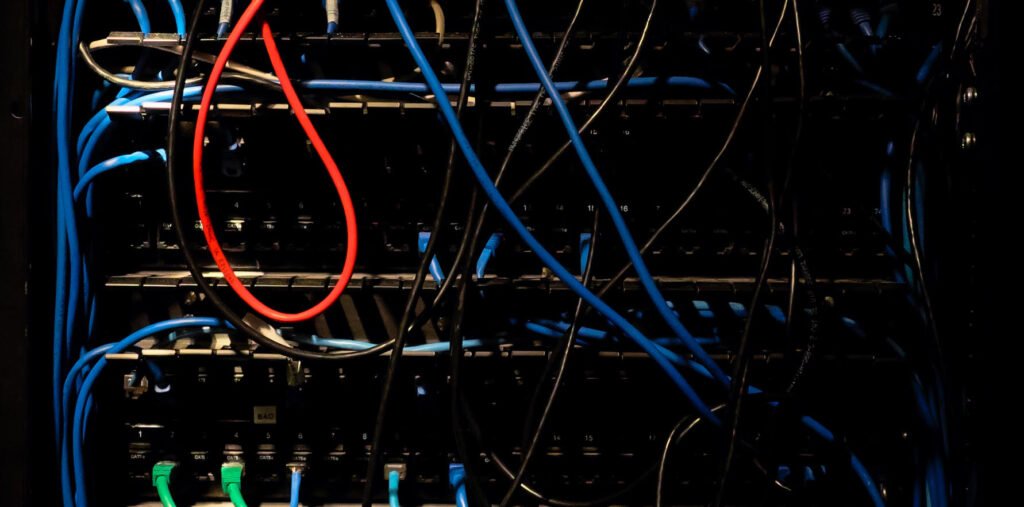The Network+ certification is a widely recognized credential for IT professionals seeking to demonstrate their knowledge and skills in networking concepts, protocols, and technologies.
To help you prepare for the Network+ exam, we have compiled a list of the top 30 assessment test questions along with their answers. These questions cover a broad range of topics and will help you assess your understanding of networking fundamentals.
1. When trouble shooting a wiring problem in your office, you find that all of the computers attach to a single wire that snakes from computer to computer. This cable starts in your office and ends at the desk of Joe in Accounting. Which of the following wiring topologies does this describe?
A. Bus
B. Star
C. Ring
D. Mesh
Correct Answer – A.
Explanation – In a bus topology, all computers are attached to a single continuous cable that terminates at both ends.
2. When trouble shooting a wiring problem in your office, you find that each computer is directly wired into a box located at the back of your office. Which of the following wiring topologies does this describe?
A. Bus
B. Star
C. Ring
D. Mesh
Correct Answer – B.
Explanation – Each computer in a star topology is connected to a central point by a separate cable. The central point is a device known as a hub.
3. When documenting a client’s wide area network, you discover that every physical location has a dedicated link to every other physical location. Which of the following wiring topologies does this describe?
A. Bus
B. Star
C. Ring
D. Mesh
Correct Answer – D.
Explanation – In a mesh topology, a path exists from each station or location to every other station or location in the network.
4. Which of the following cable types is traditionally used on Arcnet networks?
A. RG-58 AU
B. RG-58 U
C. RG-8
D. RG-62
Correct Answer – D.
Explanation – RG-62 coaxial cable is used on Arcnet networks.
5. Which of the following cables is used on 10Base2 networks?
A. RG-58 AU
B. RG-58 U
C. RG-8
D. RG-62
Correct Answer – A.
Explanation – 10Base2, or thinnet, networks use an RG-58 AU coaxial cable.
6. Which of the following OSI layers handles the function of formatting data for exchange?
A. Session
B. Transport
C. Application
D. Presentation
Correct Answer – D.
Explanation – The Presentation layer is responsible for formatting data exchange. In this layer, character sets are converted, and data is encrypted. Data may also be compressed in this layer, and this layer usually handles the redirection of data streams.
7. At which layer of the OSI model do most routing protocols function?
A. Session
B. Transport
C. Network
D. Presentation
Correct Answer – C.
Explanation – The Network layer is responsible for logical addressing and translating logical names into physical address. In addition, the Network layer controls congestion, routes data from source to destination, and builds and tears down packets. Most routing protocols function at this layer.
8. What is the media access control mechanism in which stations first determine if another device is communicating on the wire and then resends its information in the event of a collision known as?
A. CSMA/CD
B. Token Passing
C. CSMA/CA
D. Arcnet
Correct Answer – A.
Explanation – Carrier Sense/Multiple Access with Collision Detection (CSMA/CD) controls network access through a simple attempt to avoid simultaneous communication and then a procedure for handling data collision on the wire.
9. Which of the following devices work at the Network layer of the OSI model?
A. Router
B. Bridge
C. Gateway
D. Layer 3 switch
Correct Answer – A, D.
Explanation – Devices that function at the Network layer of the OSI model use network addressing information to route packets to the proper network segment.
10. What is the server that holds a writable copy of the Security Accounts Manager database known as in a Microsoft Windows NT network?
A. Primary Domain Controller
B. Backup Domain Controller
C. Master Domain Controller
D. Delta Domain Controller
Correct Answer – A.
Explanation – The PDC holds the only copy of the SAM that can accept changes. These changes are then replicated to any BDCs.
11. Which of the following TCP/IP protocols is responsible for ensuring that communication between hosts is reliable?
A. TCP
B. IP
C. ICMP
D. SMTP
Correct Answer – A.
Explanation – Transmission Control Protocol (TCP) defines the source port number and the destination port number that allow the data to be sent back and forth to the correct process running on each computer, a series of sequence numbers that allows the datagrams to be rebuilt in the correct order in the receiving computer, and a checksum that allows the protocol to check whether the data sent is the same as the data received.
12. Which of the following TCP/IP protocols is responsible for routing data to its destination?
A. TCP
B. IP
C. ICMP
D. SMTP
Correct Answer – B.
Explanation – Internet Protocol (IP) is responsible for inserting routing information into the header of each packet. This information is used by network devices, such as routers, to determine the destination of the packet.
13. If IP does not have a route to the destination host for a packet, it will forward the packet to the host’s:
A. Primary server
B. Default gateway
C. DNS server
D. WINS server
Correct Answer – B.
Explanation – When IP does not know the path to the destination, it forwards the packet to the host’s configured default gateway. The default gateway is then responsible for routing the packet to its destination. (The default gateway might, in turn, pass the packet to its own default gateway, if it also does not know the path to the destination.)
14. The IP address 190.0.40.10 is in which class of addresses?
A. Class A
B. Class B
C. Class C
D. Class D
Correct Answer – B.
Explanation – The first octet of valid class B IP addresses will be between 128 and 191.
15. The TCP/IP protocol that resolves IP addresses into MAC addresses is known as what?
A. TCP
B. IP
C. ARP
D. ICMP
Correct Answer – C.
Explanation – Address Resolution Protocol (ARP) resolves IP addresses into MAC addresses of the corresponding host.
16. The IP address 192.47.210.6 is in which class of IP address?
A. Class A
B. Class B
C. Class C
D. Class D
Correct Answer – C.
Explanation – The first octet of valid class C IP addresses will be between 192 and 223.
17. The TCP/IP configuration parameter that defines which bits represent the network portion of an address is known as the:
A. Default Gateway
B. IP address
C. Subnet mask
D. Network Identifier
Correct Answer – C.
Explanation – The subnet mask works a bit like a template that, when superimposed on top of the IP address, indicates which bits in the IP address identify the network and which bits identify the host.
18. The process of converting the user-friendly host name into its corresponding IP address is known as:
A. Address conversion
B. NAT
C. Name resolution
D. Address resolution
Correct Answer – C.
Explanation – Name resolution is the process of resolving host names into IP addresses.
19. On a Windows 95/98-based computer, which of the following ARP command line switches will display the contents of the ARP cache?
A. –a
B. –d
C. –s
D. –g
Correct Answer – A, D.
Explanation – Both the –a and –g command line switches will display the contents of the ARP cache.
20. Which of the following utilities can display a list of all outbound TCP/IP connections?
A. ARP
B. NETSTAT
C. NBTSTAT
D. IPCONFIG
Correct Answer – B.
Explanation – NETSTAT allows you to see the TCP/IP connections (both inbound and outbound) on your machine. You can also use it to view packet statistics (similar to the MONITOR.NLM utility on a NetWare server console), such as how many packets have been sent and received, the number of errors, and so on.
21. Which of the following utilities will display a list of each router that a packet passes through on its path to a destination?
A. NBTSTAT
B. IPCONFIG
C. TRACERT
D. PING
Correct Answer – C.
Explanation – The TCP/IP Trace Route (TRACERT) command-line utility will show you every router interface a TCP/IP packet passes through on its way to a destination.
22. What is it called when the electrical power to a computer drops for less than a second before returning to normal?
A. Spike
B. Surge
C. Sag
D. Brownout
Correct Answer – C.
Explanation – A sag is the opposite of a spike—power drops to unacceptable levels for a very short period of time before returning to normal.
23. Which of the following precautions would help to prevent ESD problems?
A. Installing a dehumidifying system to keep the humidity levels between 5 and 10 percent
B. Keeping the humidity levels between 40 and 60 percent
C. Ensuring that all equipment is properly grounded
D. Installing ESD preventative software on your computer
Correct Answer – B, C.
Explanation – Electrostatic Discharge (ESD) occurs when two items with dissimilar static electrical charges are brought together. Nature doesn’t like things to be unequal, so static electrical charges will “jump” from the item with more electrons. Monitoring humidity levels and ensuring proper grounding can minimize the danger of ESD.
24. Which of the following protocols transmits passwords in clear text?
A. PPP
B. SLIP
C. TCP
D. IP
Correct Answer – B.
Explanation – Serial Line Internet Protocol (SLIP) is a remote access protocol that manages the connection between a remote computer and a remote access server. It does not support the encryption of authentication traffic (and is therefore being replaced with more modern technology).
25. Which of the following would not make a good password?
A. Your name
B. Your birth date
C. The name of your pet
D. Your name spelled backwards
Correct Answer – A, B, C, D.
Explanation – Generally speaking, a strong password is a combination of alphanumeric and special characters that is easy for you to remember and difficult for someone else to guess. Each of the choices listed above are based upon information that is easily accessed.
26. Your routers maintain a list of IP addresses that are allowed to utilize the services of servers on the private side of the firewall. Which type of firewall technology does this describe?
A. ACL
B. Demilitarized zone
C. Proxy
D. Protocol switching
Correct Answer – A.
Explanation – In an Access Control List-based (ACL) firewall, each router maintains a list of those IP addresses that are allowed to use services on the private side of the firewall—effectively limiting access from unauthorized devices.
27. What is the method of providing fault tolerance to disk subsystems which involves two disks, each containing the same data, controlled by separate disk controllers known as?
A. Mirroring
B. Duplexing
C. RAID Level 5
D. Data striping
Correct Answer – B.
Explanation – Duplexing involves two disks with the exact same data on them, controlled by different controllers. If a disk, cable, or controller fails, the data on the other disk should still be available.
28. You company backs up the entire server each Sunday. Monday through Saturday, only those files that have changed since Sunday are backed up. Which backup methodology are you using?
A. Normal backups
B. Incremental backups
C. Differential backups
D. Optimized backups
Correct Answer – C.
Explanation – In a differential backup strategy, a single, full backup is typically done once a week. Every night for the next six nights, the backup utility backs up all files that have changed since the last full backup.
29. Your company backs up the entire server on Sunday. Monday through Saturday the files that have changed since the day before are backed up. Which backup methodology are you using?
A. Normal backups
B. Incremental backups
C. Differential backups
D. Optimized backups
Correct Answer – B.
Explanation – In an incremental backup, a full backup is used in conjunction with daily partial backups to back up the entire server, thus reducing the amount of time it takes for a daily backup.
30. In the Network+ troubleshooting model, which of the following steps would be earliest in the process?
A. Re-create the problem
B. Test the solution
C. Identify the exact issue
D. Give feedback
Correct Answer – C.
Explanation – In the Network+ troubleshooting model, there are eight steps performed in the following order: (1) Identify the exact issue; (2) Re-create the problem; (3) Isolate the cause; (4) Formulate a correction; (5) Implement the correction; (6) Test the solution; (7) Document the problem and the solution; and (8) Give feedback.



